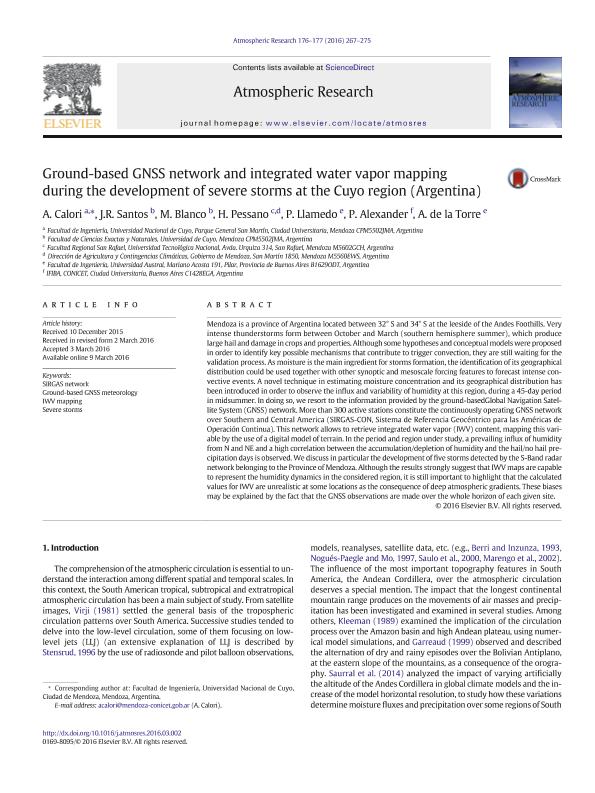Artículo
Ground-based GNSS network and integrated water vapor mapping during the development of severe storms at the Cuyo region (Argentina)
Calori, Andrea Virginia ; Santos, Jorge Ruben; Blanco Moreno, Magalí Valeria
; Santos, Jorge Ruben; Blanco Moreno, Magalí Valeria ; Pessano, H.; Llamedo Soria, Pablo Martin
; Pessano, H.; Llamedo Soria, Pablo Martin ; Alexander, Pedro Manfredo
; Alexander, Pedro Manfredo ; de la Torre, Alejandro
; de la Torre, Alejandro
 ; Santos, Jorge Ruben; Blanco Moreno, Magalí Valeria
; Santos, Jorge Ruben; Blanco Moreno, Magalí Valeria ; Pessano, H.; Llamedo Soria, Pablo Martin
; Pessano, H.; Llamedo Soria, Pablo Martin ; Alexander, Pedro Manfredo
; Alexander, Pedro Manfredo ; de la Torre, Alejandro
; de la Torre, Alejandro
Fecha de publicación:
07/2016
Editorial:
Elsevier Science Inc
Revista:
Atmospheric Research
ISSN:
0169-8095
Idioma:
Inglés
Tipo de recurso:
Artículo publicado
Clasificación temática:
Resumen
Mendoza is a province of Argentina located between 32° S and 34° S at the leeside of the Andes Foothills. Very intense thunderstorms form between October and March (southern hemisphere summer), which produce large hail and damage in crops and properties. Although some hypotheses and conceptualmodelswere proposed in order to identify key possible mechanisms that contribute to trigger convection, they are still waiting for the validation process. As moisture is the main ingredient for storms formation, the identification of its geographical distribution could be used together with other synoptic and mesoscale forcing features to forecast intense convective events. A novel technique in estimating moisture concentration and its geographical distribution has been introduced in order to observe the influx and variability of humidity at this region, during a 45-day period in midsummer. In doing so, we resort to the information provided by the ground-based Global Navigation Satellite System (GNSS) network.More than 300 active stations constitute the continuously operating GNSS network over Southern and Central America (SIRGAS-CON, Sistema de Referencia Geocéntrico para las Américas de Operación Continua). This network allows to retrieve integrated water vapor (IWV) content, mapping this variable by the use of a digital model of terrain. In the period and region under study, a prevailing influx of humidity<br />from N and NE and a high correlation between the accumulation/depletion of humidity and the hail/no hail precipitation days is observed.We discuss in particular the development of five storms detected by the S-Band radar network belonging to the Province ofMendoza. Although the results strongly suggest that IWVmaps are capable to represent the humidity dynamics in the considered region, it is still important to highlight that the calculated values for IWV are unrealistic at some locations as the consequence of deep atmospheric gradients. These biases may be explained by the fact that the GNSS observations are made over the whole horizon of each given site.
Palabras clave:
Ground-Based Gnss Meteorology
,
Iwv Mapping
,
Severe Storms
,
Sirgas Network
Archivos asociados
Licencia
Identificadores
Colecciones
Articulos(CCT - MENDOZA)
Articulos de CTRO.CIENTIFICO TECNOL.CONICET - MENDOZA
Articulos de CTRO.CIENTIFICO TECNOL.CONICET - MENDOZA
Articulos(IFIBA)
Articulos de INST.DE FISICA DE BUENOS AIRES
Articulos de INST.DE FISICA DE BUENOS AIRES
Articulos(SEDE CENTRAL)
Articulos de SEDE CENTRAL
Articulos de SEDE CENTRAL
Citación
Calori, Andrea Virginia; Santos, Jorge Ruben; Blanco Moreno, Magalí Valeria; Pessano, H.; Llamedo Soria, Pablo Martin; et al.; Ground-based GNSS network and integrated water vapor mapping during the development of severe storms at the Cuyo region (Argentina); Elsevier Science Inc; Atmospheric Research; 176-177; 7-2016; 267-275
Compartir
Altmétricas



